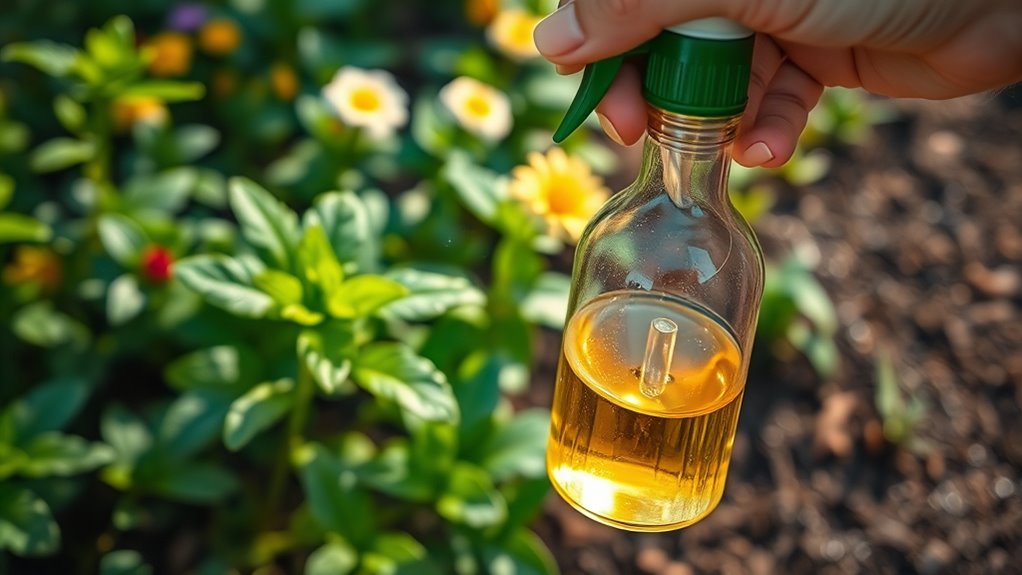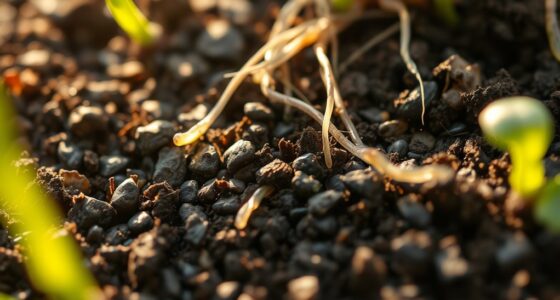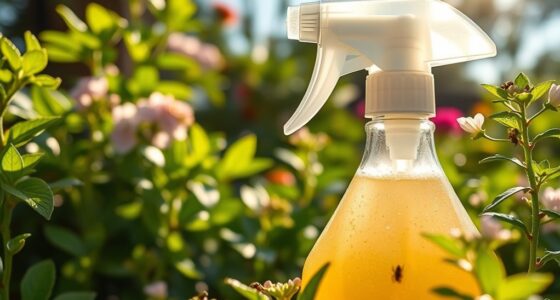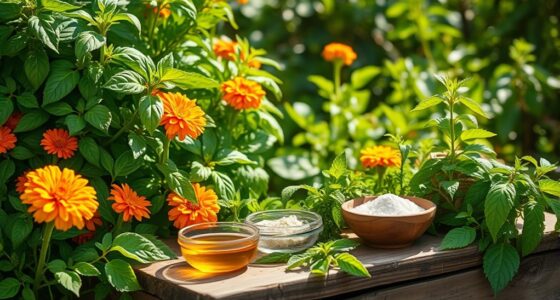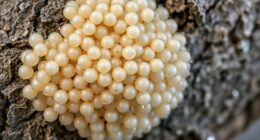To use neem oil safely, shake the bottle well and mix it with water according to the label, adding a bit of liquid soap for better coverage. Spray thoroughly on both sides of leaves during early morning or late afternoon, avoiding hot sunlight and rain. Test on a small plant area first to prevent damage. Proper application helps keep pests and fungal issues under control while protecting your plants’ health. Keep exploring for more expert tips to maximize results.
Key Takeaways
- Shake neem oil thoroughly and mix with water plus a mild liquid soap as an emulsifier before spraying.
- Apply during early morning or late afternoon to prevent leaf burn and maximize effectiveness.
- Test on a small plant area first; avoid spraying stressed or damaged plants to prevent phytotoxicity.
- Reapply weekly or every ten days, especially after rain, for sustained pest and fungal control.
- Spray both the tops and undersides of leaves evenly, focusing on pest hideouts, while following safety precautions.
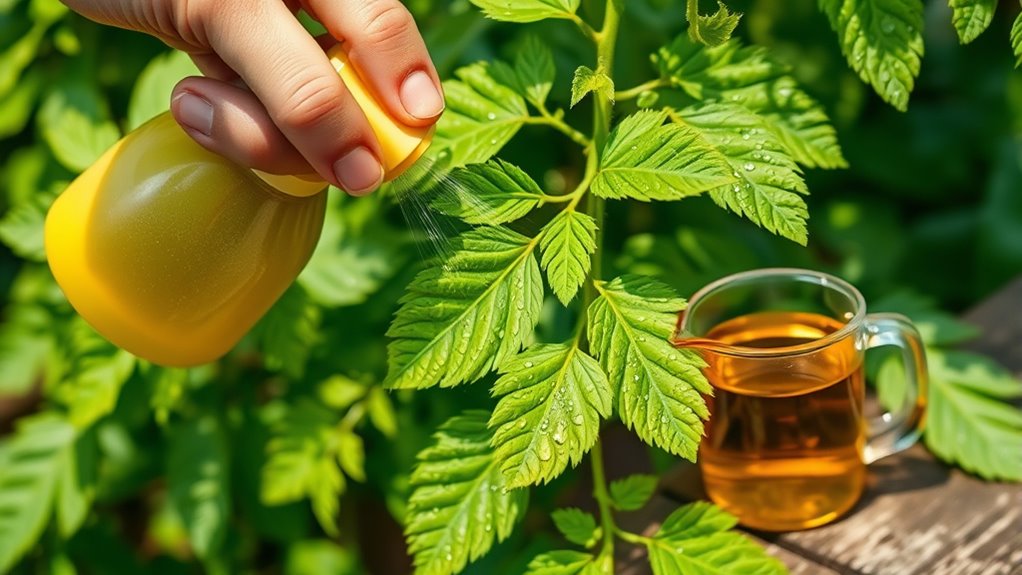
Have you ever wondered how a natural oil can transform your garden and pest control routines? Neem oil is a powerful, eco-friendly option that fits perfectly into organic gardening methods. It’s derived from the seeds of the neem tree and acts as a natural pesticide, making it a popular choice among gardeners looking to reduce chemical use. When used correctly, neem oil can help you manage pests effectively while keeping your garden healthy and safe for beneficial insects. Its versatility means you can apply it to a wide range of plants, from vegetables to ornamentals, without worrying about harmful residues.
Neem oil is an eco-friendly, natural pesticide ideal for organic gardening and pest control.
Using neem oil for pest control is straightforward, but it’s essential to follow the proper procedures to maximize effectiveness and avoid plant damage. Before applying, always shake the bottle well to ensure the oil is evenly mixed. Mix the neem oil concentrate with water according to the instructions on the label—typically a few teaspoons per gallon—and add a small amount of liquid soap. The soap acts as an emulsifier, helping the oil to spread evenly across plant surfaces. Spray the solution thoroughly on the tops and undersides of leaves, paying particular attention to areas where pests tend to hide, like leaf joints and stems. Regular applications, about once every week or ten days, can help keep pest populations under control without disrupting your organic gardening practices.
It’s important to apply neem oil during the cooler parts of the day, such as early morning or late afternoon, to prevent leaf burn caused by sunlight on the oil coating. Avoid applying neem oil during the hottest hours or in direct sunlight, as this can stress your plants. Also, check the weather forecast before spraying; heavy rain can wash away the oil, reducing its effectiveness. If rain is expected, postpone application or reapply once the weather clears. Keep in mind that neem oil isn’t just for insects—it’s also effective against fungal issues, making it a versatile tool in organic gardening. Additionally, understanding plant sensitivity can help prevent unintended damage when applying neem oil, ensuring your plants remain healthy.
While neem oil is generally safe, some plants can be sensitive to it, especially if applied in high concentrations or under harsh conditions. Always test a small area first, observing how your plants react over a day or two before proceeding with larger applications. Also, avoid spraying neem oil on stressed or damaged plants, as they may be more susceptible to phytotoxicity. By following these simple precautions, you can safely incorporate neem oil into your pest control strategy, ensuring your organic garden remains vibrant, healthy, and free from pests. In the end, neem oil offers an effective, natural way to protect your plants while supporting sustainable gardening practices.
Frequently Asked Questions
Can Neem Oil Harm Beneficial Insects in My Garden?
You might wonder if neem oil harms beneficial insects in your garden. While neem oil can impact beneficial insect populations, its toxicity is generally low when used properly. To minimize beneficial insect impact, apply neem oil during early morning or late evening when insects are less active. Always follow label instructions carefully, and avoid over-application to protect your garden’s helpful pollinators and predators.
How Often Should I Reapply Neem Oil for Pest Control?
Did you know that applying neem oil every 7 to 14 days is generally recommended? Following the frequency guidelines helps prevent overuse and protects beneficial insects. You should adjust your application schedule based on pest severity and plant response. Typically, reapply neem oil at these intervals during active pest infestations, but avoid excessive use to maintain a healthy garden ecosystem. Always monitor plants and pests closely for best results.
Is Neem Oil Safe for Edible Plants and Vegetables?
You’re wondering if neem oil is safe for edible plants and vegetables. Generally, it’s safe when used properly, as it doesn’t harm soil health or reduce crop yield if applied according to instructions. You should spray it during early morning or late evening, avoiding harvest times, and rinse vegetables thoroughly before eating. This helps protect your plants, maintain healthy soil, and ensure a good crop yield.
Can Neem Oil Be Used on Indoor Houseplants?
Imagine your indoor garden as a delicate symphony, where each plant plays a essential note. You can use neem oil safely in this harmony by practicing good indoor plant care, ensuring proper dilution, and applying it during low light hours. Neem oil safety for houseplants is high when you follow these steps, keeping pests at bay without risking harm. Just like a conductor, maintain balance for a thriving, pest-free indoor oasis.
Are There Any Plants That Should Not Be Treated With Neem Oil?
Some plants are best avoided when using neem oil, especially toxic plant species and sensitive plant varieties. You should steer clear of neem oil on plants like ferns, succulents, and certain orchids, as they may react negatively. Always check your plant’s specific needs before treatment. If unsure, test a small area first and observe for any adverse reactions, ensuring your plants stay healthy and safe.
Conclusion
By using neem oil correctly, you protect your plants naturally and effectively. Just remember, over 70% of gardeners report healthier, pest-free plants after consistent neem oil use. Always follow the recommended application directions and avoid applying during peak sunlight hours to prevent damage. With proper use, neem oil becomes your eco-friendly weapon against pests, keeping your garden safe and vibrant. Start incorporating neem oil today and enjoy a thriving, chemical-free garden all season long.
